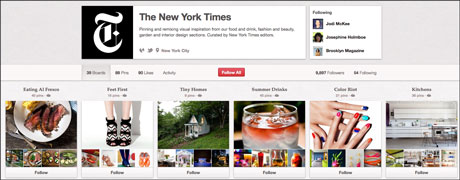
In February Liz Heron, a former social media editor of the New York Times, gave a keynote presentation to Journalism.co.uk's digital journalism conference news:rewired and spoke about the seven ways the Grey Lady's social team had been innovating.
Six months on and we recently caught up with social media editor Alexis Mainland (who was co-editor of social media along with Heron) about five of the innovations she is particularly proud of at the New York Times.
1. Twitter at the Olympics - 'getting personal and detailed' with live and catch-up Twitter coverage
The New York Times has a Twitter account dedicated to the Olympics called @LondonLive. "It's active almost 24 hours a day and it's completely hand-reported and curated," Mainland said.
The tweets are also displayed on the homepage of NYTimes.com and in the Olympics section where they are "in the centre of the page and really anchoring the live element there".

And because of the time delay between the events taking place and being broadcast in the US, the team has taken a creative approach.
"During the actual live events in London we have reporters who are at the given sporting events live tweeting through @LondonLive with all the action of whatever the most important event of the day is."
For example, on Thursday (2 August) the title's gymnastics correspondent live tweeted for two hours throughout the men's gymnastics and then handed over to another reporter who live tweeted the swimming events.
Journalism.co.uk spoke to Mainland by phone a few hours before she was due to embark on a night shift, as after the events are over the team then tweets while the games are broadcast on US television.
"We live tweet all the highlights again and point back to our coverage and ask questions," Mainland explained.
They also tweet trivia questions and later answer them on Twitter, which can also be seen in the Q&A section of the Olympics part of the site.
"Whenever someone is watching the Olympics we are there with them on this account to watch with them, whether they are watching live or they are watching the US broadcast.It has been the most personal and detailed effort that we have ever undertaken on Twitter for the New York TimesAlexis Mainland, social media editor
"It's been really fun and we have got a great response. It has been the most personal and detailed effort that we have ever undertaken on Twitter for the New York Times."
The title took a similar approach during Hurricane Irene, live tweeting from @NYTLive.
"That event lasted four days and then we put the account to bed until we had another reason to use it and it pops up sporadically. But @LondonLive is a full two-and-a-half-weeks of 24 hours-a-day great, great twittering."
2. Google+ Hangouts On Air - going for quality in broadcasting video conversations
The New York Times has put a lot of effort into Google+ Hangouts, with the opinions team experimenting with online video conversations broadcast simultaneously on YouTube, the New York Times site and the title's Google+ page.
The newspaper's opinions team has been experimenting, including broadcasting a hangout hosted by Nicholas Kristof, in which he spoke to Susan Rice, the US ambassador to the United Nations. The hangout ran on the homepage of the New York Times, broadcasting live for 25 minutes.
"We have been putting a lot of production efforts into Google+ Hangouts," Mainland said. "We've sort of been taking a an opposite approach to some other organisations, which are smartly using them with a low production effort in a way to spin off a conversation.
"But we've taken a different approach and we are really looking at them as these little ecosystems where we have put a lot of effort into finding out the ideal participants from among our readership and our Google+ community."
For the Kristof and Rice hangout Mainland and colleagues spoke to nearly 100 people to find and select five really strong contributors.We've been incredibly judicious and instead of doing a lot of hangouts, tried to do fewer of them that have had a bigger impactAlexis Mainland
"We've been incredibly judicious and instead of doing a lot of hangouts, tried to do fewer of them that have had a bigger impact."
The Olympics have also inspired hangouts, with a series of five including Olympians and readers.
"We've been using some of the quotes that the athletes gave us in those hangouts, or the moments between them and our readers, back in our daily video stories about the Olympics."
And there will be more hangouts. Mainland is "in the full throes of finding participants for a series of hangouts we are going to be doing from the political conventions later this month".
3. Facebook - personalising the page
One of the recent focuses on Facebook is the New York Times timeline, which shows the 160-year history of the Grey Lady.
The news outlet was the first to populate its timeline with milestones from the years, partnering with Facebook at the launch of the feature for pages.
"We are fairly frequently adding New York Times coverage milestones into that timeline," Mainland said.
For example, when the astronaut Sally Ride died last month, the team posted and date tagged the front page of the newspaper reporting her journey into space.
Another feature the 2.2 million followers of the New York Times's Facebook page see is a changing cover photo, which introduces the community to another New York Times face.
Once a month the photo is switched to a different photo of a New York Times journalist in the field. Currently the picture is of 82-year-old fashion photographer Bill Cunningham (see above).
"We feel that Facebook is all about people and as Facebook brand pages now look identical for the most part to personal Facebook pages, so it is almost like it's the New York Times person's page."
Another area of Facebook innovation is encouraging reporters to use Facebook Subscribe with more than 75 now using the feature.
"Beat reporters have embraced Facebook Subscribe," Mainland said. "A lot of our Metro reporters who report on New York are using and enjoying it."
4. Pinterest - personal pins
The New York Times launched on Pinterest this summer. The team has opted to "tightly focus" on three topics they knew to be among the most popular on Pinterest. They pin photography from the fashion section, food section and the home design section.

"Wherever we are on social networks we want to really understand the community and want to be strategic about what we are doing on that platform so that it makes sense and that it is likely to be the most engaging for the people there."
The majority of photos are selected and pinned by the journalist who works on that section and Pinterest users can see who pinned them and can click on the journalist's thumbnail to discover their role.
"One thing we noticed is that, like Facebook, Pinterest is all about each individual person's taste and so we thought it would be missing something if each pin was just pinned by the New York Times.
"So each person who is working on this project has their own Pinterest account and they pin from their own account, into the New York Times board, which they are a collaborator on."
5. Tumblr - getting political
Yesterday we reported how the New York Times has launched its third Tumblr blog. The Agenda Tumblr "remixes" political coverage taking place elsewhere on the New York Times into a Tumblr blog in order to engage with the community of the blogging and social media hybrid.
The Agenda adds to two other Tumblrs: T Magazine, which showcases the title's fashion photography, and The Lively Morgue, the newspaper's photographic archive (and a smart way of selling prints).There's so much you can do on social media that it can fill up your whole day, but the things that people remember as hitting them emotionally are the things that are really, really goodAlexis Mainland
The Agenda "is a gathering place for all sorts of things going on on NYTimes.com in disparate places on our site, and it brings them together under one umbrella", Mainland said.
"The whole point of having a Tumblr was to really engage a community that, coming up to the elections, seems very focussed on a lot of these issues. We are hoping that people re-blog these posts and add their own interesting commentary to them and we can see how this kind of content is impacting the conversation on Tumblr."
Asked to reflect on the title's approach to social media, Mainland said her goal is quality and the personal touch.
"I'm interested in the most meaningful and high-quality experiences that we can create. There's so much you can do on social media that it can fill up your whole day, but the things that people remember as hitting them emotionally are the things that are really, really good."
Free daily newsletter
If you like our news and feature articles, you can sign up to receive our free daily (Mon-Fri) email newsletter (mobile friendly).
Related articles
- Axel Springer CEO on OpenAI deal: 'We must protect intellectual property of news content'
- Audiences, AI and audio apps: five talking points from Perugia
- 10 creative ways to interview celebrities and experts
- Five key takeaways from the UK select committee on the future of news
- From Reuters to The New York Times, Big Oil pays 'most trusted media brands' to push greenwashing









